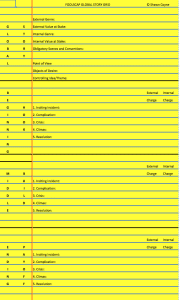Download the Math of Storytelling Infographic
An editor handed a pile of manuscript pages must answer a whole bunch of questions before he can even begin to diagnose the effectiveness of the storytelling. While he’ll know after one read whether or not the book “works,” in order to take the book to the next level, he’ll have to figure out exactly how it is working. He has to put the whole book onto one page.
To refresh your memory, here are the six questions he must answer:
- What’s the genre?
- What are the conventions and obligatory scenes for that genre?
- What’s the Point of View?
- What are the objects of desire?
- What’s the controlling idea/theme?
- What is the Beginning Hook, the Middle Build, and Ending Payoff?
The Foolscap Global Story Grid is that one page document. Once he’s read the book [just one time] if the book is well conceived he should be able to fill in the blanks of The Foolscap Global Story Grid without having any serious head scratches.
When you boil down an entire Story to one page, there is no place for a writer or an editor to bullshit himself. It’s an indispensable tool to check your work.
But don’t forget that it is a diagnostic tool and not a recipe. You could have a brilliantly laid out Foolscap Global Story Grid before you begin writing and the Story itself could fizzle completely. Or you may have what seems to be a rather generic Foolscap Global Story Grid that results in a timeless work of art. Execution is everything.
If you cannot execute the plan, The Foolscap Global Story Grid will not result in a great story. You could have the best architectural plans, but If you are a lousy carpenter or plumber or electrician, the house is going to have flaws. But those kinds of flaws are fixable through perseverance and hard work and dedication to craft. But an ill-conceived Foolscap Global Story Grid is fatal. The Story won’t work.
But again, The Foolscap Global Story Grid is not an end to itself. It’s not even something to show anyone else unless he is your editor or a fellow scribe in need of a helping hand. To go back to our metaphor, it’s an architectural layout for a building, not a building.
Don’t torture yourself over it unless you really have to.
What The Foolscap Global Story Grid can do for you if your story isn’t working is immeasurably helpful. It will show you where you went wrong. Where you jumped off track, got lazy, fell in love with a scene instead of making sure the scene served your story, etc. It will show you where your problems are, where there’s a leak in your plumbing, a short in your wiring etc. and thus it will take away quite a bit of that inner self loathing and destructive behavior we all face when we have a very very rough first draft. You as the writer are not the problem, the problem is the problem. The Foolscap Global Story Grid will tell you where your problems are.
It will take away a lot of emotional sturm and drang and keep you working. You’ll use it to make discernible progress. It will keep you from desperately seeking “notes” from friends or acquaintances who know nothing about Story structure. It will make you a much better storyteller and as you use it more and more, you’ll become a far better writer.
Eventually you’ll do the work of The Foolscap Global Story Grid intuitively. But you’ll always be able to fill it in at the first sign of trouble.
Now, let’s move down The Foolscap Global Story Grid from top to bottom and explain exactly what we need to fill in.
The first line we need to fill out is the External Genre, which is one of the nine external content genres I detailed here along with it’s sub and/or sub-sub genre classification. So for The Silence of the Lambs, the External Content Genre would be THRILLER, along with its subgenre classification SERIAL KILLER
External Genre: Serial Killer Thriller
The External Value at Stake in a Thriller is a convention. It is Life. To remind myself of the progression of the value, I’ll move it from its positive value to its most negative:
External Value at Stake: Life to Unconsciousness to Death to Fate Worse than Death (Damnation)
One of the Internal Genres that I discussed here is also a very major component of The Silence of the Lambs. I’ll do a much more in-depth analysis of why I’ve designated it the way that I have later on when I walk you through the entire Story Grid for The Silence of the Lambs.
Internal Genre: Worldview Disillusionment
The Internal Value at Stake in a Worldview Internal Story is, what you’d expect. The way in which the protagonist views the world. It will arc from negative to positive or positive to negative depending upon your subgenre. In the case of The Silence of the Lambs, it arcs from what I see as a “false positive view” to a proven negative and it does so through the prism of Clarice Starling’s professional ambition. It moves like this:
Internal Value at Stake: Blind Belief to True Belief to Doubt to Disillusionment
Next up…I’ll lay out the obligatory scenes and conventions of the Thriller.
For new subscribers and OCD Story nerds like myself, all of The Story Grid posts are now in order on the right hand side column of the home page beneath the subscription shout-out.
Download the Math of Storytelling Infographic
Share this Article:
🟢 Twitter — 🔵 Facebook — 🔴 Pinterest
Sign up below and we'll immediately send you a coupon code to get any Story Grid title - print, ebook or audiobook - for free.
(Browse all the Story Grid titles)
